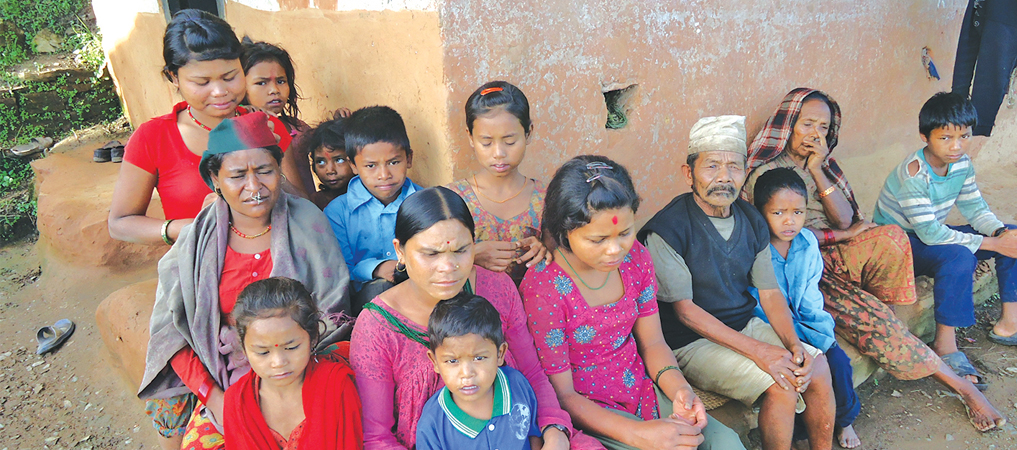Breathing life into dying Kusunda language

By Shaurya Kshatri
Kathmandu, Dec. 7: For centuries the now endangered Kusundas roamed the dense forests of Nepal foraging the wild for food. With cords of wild creepers, they ensnared clawed birds and with bows and
arrows, hunted monitor lizards and palmed civets.
But apart from their semi-nomadic culture, the most fascinating aspect of the tribe has always been their unique language, which to this day baffles linguists and anthropologists all across the world. “In linguistic terms, the Kusunda Bhasha is referred to as a language isolate, meaning that it has no proven genealogical relation to other language families around
the world,” informs linguist Madhav Pokharel.
Today, with less than 150 of the Kusundas scattered across parts of the country in Surkhet, Dang, Tanahun, and Gorkha, they are among the most seriously endangered relic tribes of the country. Their once semi-nomadic culture has all but ceased to exist and their language hangs on the verge of extinction.
While several attempts have been made in the past to revive the forgotten language, a recent initiative aims to immerse the viewers into the dying culture of the Kusundas.
Bombay-born but Berlin-based filmmaker and immersive journalist, Gayatri Parameswaran, is currently working on her docufiction KUSUNDA, a virtual reality documentary that will explore what it means to lose a language and what it takes to keep one alive. NowHere Media, a Berlin-based virtual reality and augmented experience studio founded by Parameswaran herself, is currently working on
creating 3D visuals and animation for the project.
Narrated by two native Kusundas of Pyuthan, 86-year-old Kusunda shaman Lil Bahadur Kusunda and his 15-year-old granddaughter Hema, the documentary upon completion will recount the experience of two generations set apart by their lifestyles and brought together by the struggle for their indigenous identity. “Lil Bahadur is a healer, who as a child grew up in the forest before relocating to villages after marriage,” explains Uday Raj Aley, author of Kusunda Tribe and Dictionary and a
prominent figure in conservation of Kusunda culture.
Author Ale, who has also been closely involved with the NowHere Media crew in making the VR experience, connected The Rising Nepal with Berlin-based filmmaker Parameswaran. Talking about the project, Parameswaran says that Lil Bahadur is visualised in the documentary as his younger self. While Lil Bahadur, via voiceover, paints a glimpse into the past with anecdotes of his life in the jungle, viewers will also be able to watch it all unfurl in front of them thanks to cutting-edge 3D animations.
On the other side of the spectrum is Lil Bahadur’s granddaughter, Hema, who in the documentary shares her experience in learning the Kusunda language. Currently, studying in Grade IX, Hema, although detached from her grandfather’s hunter-gatherer lifestyle, is keen to preserve her ancestral culture and language. “Lil Bahadur has forgotten the Kusunda language but Hema, on the other hand, is one of the brightest students who has made significant progress,” says Ale, who before the demise of Gyani Maya Kusunda, one of the last fluent speaker of the language , ran Kusunda language classes in collaboration with the Language Commission at Lamahi and Ghorahi, Dang. Both late Gyani Maya and 48-year-old Kamala Khatri taught aspiring young Kusunda speakers. “After Gyani Maya’s death, now Kamala ji is the last person fluent in the language,” worries Ale.
Since the classes were dismissed following Gyani Maya’s demise in January this year, keen students like Hema have been deprived of the only means of learning language. According to Ale, it’s still uncertain as to when the classes will resume.
Being solely oral, the language doesn’t have any written script rendering the archiving and preservation all the more challenging. However, along with the Language Commission, researcher Uday Raj Ale is currently working on the first-of-its-kind Kusunda course book replete with word recognition, and sentence structure guidelines.
Apart from this, Ale has also lent his voice to NowHere Media’s ‘Speak To Awaken’ campaign, where people can learn words from Kusunda language following Ale’s pronunciation.
“Death of a language is a severe blow to both the historical legacy and tradition of a culture. Hopefully, such innovative exploration like VR might help garner interest in the endangered Kusunda tribe,” concludes Ale.
Recent News

Do not make expressions casting dout on election: EC
14 Apr, 2022
CM Bhatta says may New Year 2079 BS inspire positive thinking
14 Apr, 2022
Three new cases, 44 recoveries in 24 hours
14 Apr, 2022
689 climbers of 84 teams so far acquire permits for climbing various peaks this spring season
14 Apr, 2022
How the rising cost of living crisis is impacting Nepal
14 Apr, 2022
US military confirms an interstellar meteor collided with Earth
14 Apr, 2022
Valneva Covid vaccine approved for use in UK
14 Apr, 2022
Chair Prachanda highlights need of unity among Maoist, Communist forces
14 Apr, 2022
Ranbir Kapoor and Alia Bhatt: Bollywood toasts star couple on wedding
14 Apr, 2022
President Bhandari confers decorations (Photo Feature)
14 Apr, 2022










